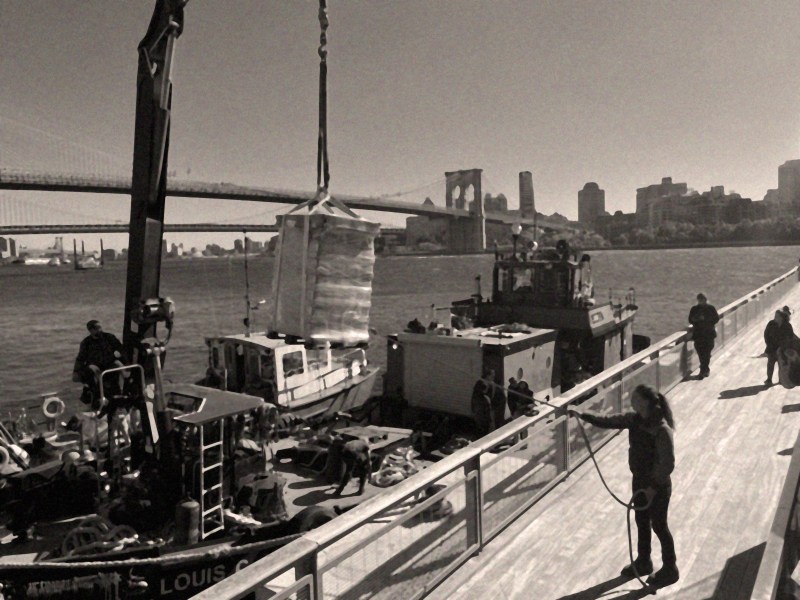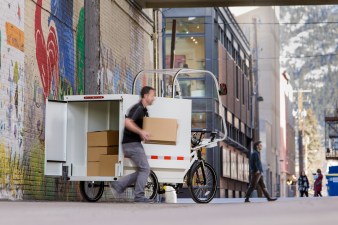The Blue Highway: City EDC Takes a Major Step Forward for Cleaner Freight

To paraphrase the old song: Four loaded pallets of beer on the boat, four loaded pallets of beer — if somebody somewhere would just build a pier … more and more pallets of beer on the boat.
The city’s Economic Development Corporation will make key infrastructure improvements to several city piers to jumpstart the use of the so-called “blue highways” to move freight that is currently almost entirely delivered in trucks with disastrous impact on the air, the roads, and sanity.
The piers — starting with three, likely in Lower Manhattan, Brooklyn and The Bronx — will get floating docks and hardware so that freight can be loaded on and off boats, plus staging areas where the cargo can be put onto small trucks or, eventually, cargo bikes for “last mile” deliveries. A $5.2-million federal grant will allow the city to start making the improvements to the piers, which, ironically, are not equipped to handle freight in a world where trucks dominate the distribution system.
“This grant really gets us started,” said Andrew Genn, EDC’s senior vice president for transportation planning, who will announce the federal grant on Friday. “We have docks, but we need a way for boats to be loaded and unloaded and for goods to be rolled off onto vehicles for last-mile deliveries. The $5 million is pretty impactful. This is our incubator.”
The announcement comes just days after Streetsblog got a first-hand look at an effort by Manhattan Beer Distributors, a major suds freight company, to use the East River to send four pallets of beer — roughly 120 cases — from its facility in the Oak Point section of The Bronx to several restaurant clients at the South Street Seaport, a “back to the future” initiative to reimagine New York’s celebrated seafaring past for a future with fewer truck deliveries.
Judging from the maiden voyage, one would need a good imagination. First, the beer had to be loaded at the pier in Oak Point — curiously, one of the six piers that was in the EDC’s federal grant application — which required a separate boat with a crane, the Legs III belonging to Maritime Projects LLC, to take the pallets from the pier to the awaiting boat, the Helen A, belonging to Brooklyn Marine Service and captained by Mike Abegg.
Abegg took the cache down river to Pier 17 — using the tides to reduce his power use — where it met up with another crane boat, Lehigh Marine’s Louis C, which did the unloading (pictured in the start-to-finish slideshow below).
The arrival at South Street Seaport’s Pier 17 shows the current limitations of moving freight this way: despite its name, Pier 17 can’t currently handle real freight deliveries. And if Manhattan Beer’s customers weren’t right there — on Pier 17 — the entire pilot couldn’t have even been contemplated because there’s no staging area to make it easy to get the goods from the boat to the trucks or cargo bikes.
That’s where the federal money comes in.
“We did this because it was a small amount of beer to a single spot,” said Alex Bergson of Manhattan Beer. “It wasn’t perfect, but you have to start somewhere.”

Bergson said that the boat ride took only a single truck off the road — and that’s overstating it because the run from The Bronx (or Manhattan Beer’s Brooklyn warehouse) would have only been a small part of the day’s work for one truck driver. Manhattan Beer has 350 routes per day among its five facilities.
But the potential is there once the city finishes work at all of the six piers that it is eyeing (Pier 36, the Downtown Heliport and the 23rd Street Skyport in Manhattan; 25th Street and 29th Street piers in Brooklyn; and Oak Point).
“Our job is to get beer from point A to point B, and this was a chance to find a new way to move it,” he said, crediting EDC and consultant Paul Lipson, who has been the go-between among the city, marine companies and distributors. “For this to work, a lot of infrastructure has to be built so we can load on, roll off and get product to customers who aren’t right on the pier.”
Bergson said the need goes beyond the pier. Current e-bikes, he said, aren’t able to carry hundreds of pounds yet, and even when they are, their operators will need charging infrastructure. (But that’s on the horizon, too, as the EDC and the Department of Transportation collaborate on what it sometimes calls “Delivering Green” or the “Blue Highways Program” to better exploit the waterways, even as the DOT tries to clean up street deliveries). Ironically, the city website features a picture of what good last-mile distribution looks like — but it’s from London.

Lipson, the principal at Barretto Bay Strategies and a longtime champion of The Bronx, says any investment in water-borne distribution will pay off. The South Bronx, Red Hook and Sunset Park are just three neighborhoods that have seen a massive increase in “last-mile” distribution hubs that have unleashed caravan after caravan of trucks, thanks in part to your neighbors’ addiction to ordering online. The problem has gotten so bad that activists have proposed a zoning change to regulate warehouse activity, as Streetsblog reported.
“Roadway congestion and poor air quality are not inevitable corollaries to economic activity,” said Lipson. “For every community that has struggled with unprecedented levels of last-mile truck traffic and endured the unequal impacts and diminished air quality associated with the last-mile industry, inter-borough maritime freight is a more responsible and sustainable way forward. These neighborhoods deserve no less.”
The $5.2 million from the feds will only fund the first three pier modernizations (the city has 12 piers, some of which are already built out), but more is on the way, promised EDC President and CEO Andrew Kimball.
“It is high time that New York City capitalize on the opportunities marine highways can provide and reimagine how we move freight across the five boroughs,” Kimball in a statement. “The increased utilization of our waterways coupled with this funding will spur the transformation of commercial transportation – resulting in a greener city with reduced congestion and pollution as well as a stronger more resilient economy.”
Bergson would be one a beneficiary, though he knows it won’t be in the short term.
“I don’t expect this to go extremely quickly,” he said. “They do this all over Europe, but for us, this is new and cutting edge.”



